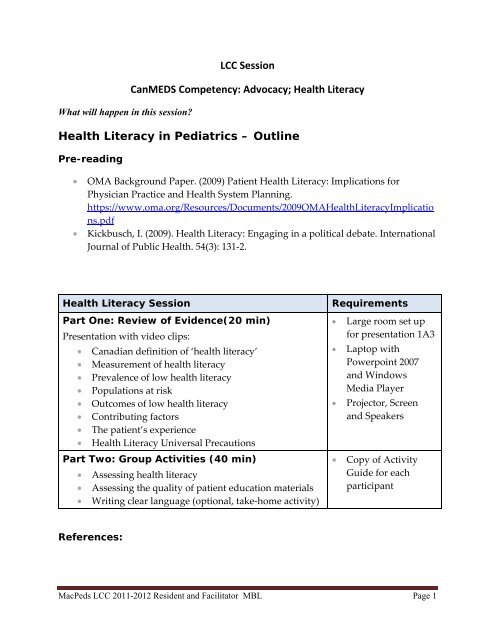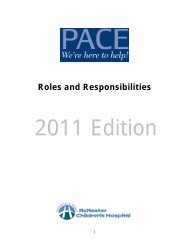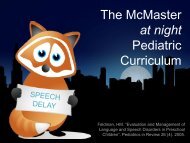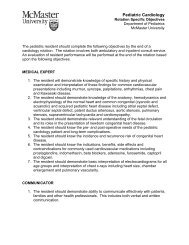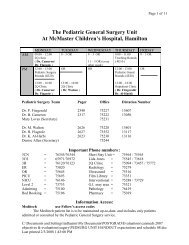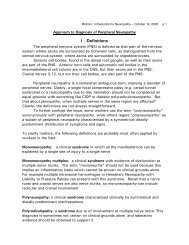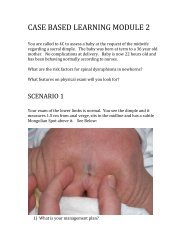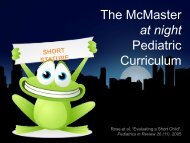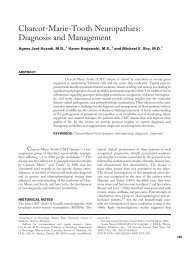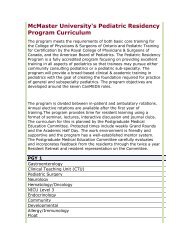Health Literacy in Pediatrics - McMaster Pediatrics Residency Program
Health Literacy in Pediatrics - McMaster Pediatrics Residency Program
Health Literacy in Pediatrics - McMaster Pediatrics Residency Program
You also want an ePaper? Increase the reach of your titles
YUMPU automatically turns print PDFs into web optimized ePapers that Google loves.
<strong>Health</strong> <strong>Literacy</strong> <strong>in</strong> <strong>Pediatrics</strong> 2012Who is most at risk?• born outside Canada• limited proficiency <strong>in</strong> English/French• low education• low <strong>in</strong>come, unemployed• older adults (over 65 yrs)Canadian Council on Learn<strong>in</strong>g, 2008; Rootman & Gordon-El-Bihbety, 2008Canadian Council on Learn<strong>in</strong>g: <strong>Health</strong> <strong>Literacy</strong> Map www.ccl-cca.caWhy does health literacy matter?Low health literacy is associated with:• poorer health• chronic disease• medication errors• less preventative care• more emergency care• <strong>in</strong>creased hospitalization• higher mortality (seniors)<strong>Health</strong> literacy impacts• Access to care• Patient safety• Quality of care• <strong>Health</strong> outcomesAHRQ, 2011; Canadian Council on Learn<strong>in</strong>g, 2008It’s a ‘silent epidemic’People with low health literacy:• Tend not to ask questions• Rely on other sources of <strong>in</strong>formation• Use effective cop<strong>in</strong>g skills• Don’t want you to know!Patients who nod and don’t ask questions are be<strong>in</strong>g polite.It doesn’t mean that they understand.What affects health literacy?<strong>Health</strong> literacy emerges from the<strong>in</strong>teraction among these factorsPersonProvidersProductsPlacesL<strong>in</strong>dsay Wizowski, ext 46624Patient Education Services 2
<strong>Health</strong> <strong>Literacy</strong> <strong>in</strong> <strong>Pediatrics</strong> 2012PersonHow do parents feel?• anxious• tired• stressed• frustratedHow literate are parents?Percent of Canadians 16 to 35 years of agewith below proficiency literacy skillsStatistics Canada (2005) Build<strong>in</strong>g on our competenciesProviders• What is the strongestpersonal factor <strong>in</strong>predict<strong>in</strong>g higher levelsof health literacy?You have acutes<strong>in</strong>usitisThat’s Why, thankgood,right?you!Canadian Council on Learn<strong>in</strong>g, 2008Daily read<strong>in</strong>gCommon mistakesDeliver<strong>in</strong>g too much <strong>in</strong>formation, too fast.Us<strong>in</strong>g jargon and difficult language.Not check<strong>in</strong>g for understand<strong>in</strong>g.ProductsPr<strong>in</strong>t and onl<strong>in</strong>e <strong>in</strong>formationis complexSay what?<strong>Health</strong> <strong>in</strong>formation is everywhere.Much of it is conflict<strong>in</strong>g or confus<strong>in</strong>g.I understand that therationale for undertak<strong>in</strong>gthis procedure <strong>in</strong>cludesrestoration ofbiomechanical alignmentof affected segments <strong>in</strong>preparation for cont<strong>in</strong>ued,and more comfortable,deformity managementwith othoses.Over 1000 studies: Mismatch between read<strong>in</strong>g level of materials and read<strong>in</strong>g skills of adultsL<strong>in</strong>dsay Wizowski, ext 46624Patient Education Services 3
<strong>Health</strong> <strong>Literacy</strong> <strong>in</strong> <strong>Pediatrics</strong> 2012PlacesHospital environmentMost peoplesuffer hear<strong>in</strong>g losswhen naked.• unfamiliar, scary• busy, noisy• distractions, <strong>in</strong>terruptions• confus<strong>in</strong>g signage<strong>Health</strong> care system’s expectationsLow health literacyWe expect patients and families to be:• <strong>in</strong>formed• activated• computer literate• self-manag<strong>in</strong>g• partners <strong>in</strong> carePerson’scapacitySystem’sdemandsWhat can you do?<strong>Health</strong> <strong>Literacy</strong>UniversalPrecautions1Create a shame-free experience1. Create a shame-free experience2. Use clear language3. Use resources to make teach<strong>in</strong>gmore effective4. Use teach-back to check forunderstand<strong>in</strong>g• Anticipate that patients and parents mayhave trouble understand<strong>in</strong>g health<strong>in</strong>formation.• Convey an attitude of helpfulness, car<strong>in</strong>gand respect.• Welcome a support person.• Encourage questions, listen.• Provide help with forms.L<strong>in</strong>dsay Wizowski, ext 46624Patient Education Services 4
<strong>Health</strong> <strong>Literacy</strong> <strong>in</strong> <strong>Pediatrics</strong> 20122 Use clear languageF<strong>in</strong>d a simpler way to say it• A way of speak<strong>in</strong>g and writ<strong>in</strong>g that iseasy for most people to understand.• Uses familiar, everyday (non-medical)language and a conversational style.• per• onset• elevated• hand hygiene• monitor the site• practice social distanc<strong>in</strong>g3Use resources• Blood tests should be drawn 4 hourspost <strong>in</strong>jection.• Surgery may be required afterexhaust<strong>in</strong>g all non-operative treatments.• Ensure your child wears appropriateage/activity related protectiveequipment dur<strong>in</strong>g physical activities.• A comb<strong>in</strong>ation of methodsmakes teach<strong>in</strong>g moreeffective.• Choose or developmaterials that are easy toread and understand.• Mark them up!Indicate key po<strong>in</strong>ts(underl<strong>in</strong>e, circle).Individualized and InteractiveClear language benefits everyonePatient Education LibraryIn the MCH study,parents were satisfiedwith clear languagematerials, regardlessof their health literacyskills.Grade 5.7Hospital guidel<strong>in</strong>es for develop<strong>in</strong>gpatient education materialsSearch for clearlanguage materialsL<strong>in</strong>dsay Wizowski, ext 46624Patient Education Services 5
<strong>Health</strong> <strong>Literacy</strong> <strong>in</strong> <strong>Pediatrics</strong> 20124Check for understand<strong>in</strong>gIneffective AmbiguousOK?All right?• The responsibility for communicat<strong>in</strong>gclearly is yours.LesseffectiveClosedendedDo you understand?Do you have any questions?Does this make sense?• How do you know if a patientunderstands and knows what to do?EffectiveOpenendedWhat questions do you have?What parts of this are hard tounderstand?MosteffectiveTeach backTo make sure I expla<strong>in</strong>ed thisclearly, could you tell/show mewhat you are go<strong>in</strong>g to do?Teach backOne of the top patientsafety practicesTeach back• Ask patients to repeat <strong>in</strong> their ownwords what they need to know or do.Teach• Not a test of the patient, but of howwell YOU expla<strong>in</strong>ed a concept.Check• A chance to check for understand<strong>in</strong>gand, if necessary to re-teach the<strong>in</strong>formation <strong>in</strong> a different way.“Clos<strong>in</strong>g the loop”ClarifyUnderstand<strong>in</strong>gNational Quality Forum, 2010Schill<strong>in</strong>ger et al, 2003Americal Academy of <strong>Pediatrics</strong>SummaryAny patient or parent <strong>in</strong> your practice can havedifficulty understand<strong>in</strong>g health <strong>in</strong>formation.Low health literacy affects their health and safety,as well as the quality of their care and experienceat the hospital.You can help by:1. Creat<strong>in</strong>g a shame free experience2. Us<strong>in</strong>g clear language3. Us<strong>in</strong>g resources to re<strong>in</strong>force teach<strong>in</strong>g4. Us<strong>in</strong>g teach back to check for understand<strong>in</strong>gL<strong>in</strong>dsay Wizowski, ext 46624Patient Education Services 6
<strong>Health</strong> <strong>Literacy</strong> <strong>in</strong> <strong>Pediatrics</strong> 2012L<strong>in</strong>dsay Wizowski BScN MEdPatient Education SpecialistHamilton <strong>Health</strong> SciencesExt. 46624wizowski@hhsc.caL<strong>in</strong>dsay Wizowski, ext 46624Patient Education Services 7
Activity 1: Assess<strong>in</strong>g health literacyThe Newest Vital Sign is a screen<strong>in</strong>g tool to identify patients at risk for lowhealth literacy. The NVS consists of a nutrition label accompanied by six questionsthat assess the patient’s read<strong>in</strong>g and numeracy skills. The tool can be adm<strong>in</strong>istered<strong>in</strong> a cl<strong>in</strong>ical sett<strong>in</strong>g <strong>in</strong> just three m<strong>in</strong>utes.Scor<strong>in</strong>g:0 to 1 = Low health literacy is likely (greater than 50% chance that patienthas marg<strong>in</strong>al or <strong>in</strong>adequate health literacy and is at significant riskfor poor health outcomes)2 to 3 = Low health literacy is possible4 to 6 = Adequate health literacyThe score provides <strong>in</strong>formation about the patient that will allow health careproviders to adapt their communication practices <strong>in</strong> an effort to achieve betterhealth outcomes.1. Simulation: In your group, choose one person to play the role of a parent andanother person to be the pediatric resident. The sett<strong>in</strong>g is a hospital pediatricoutpatient cl<strong>in</strong>ic. This is the child’s first visit. At this cl<strong>in</strong>ic, a health literacy test isadm<strong>in</strong>istered to a parent/caregiver as part of the family’s <strong>in</strong>itial assessment.2. Assess the parent’s health literacy:The resident gives the parent the nutrition label. The parent can refer to it whileanswer<strong>in</strong>g questions. It is not necessary to give parents time to review the labelbefore ask<strong>in</strong>g the questions. Rather, they will review the label as they are askedand answer the questions.The resident asks the questions and records the patient’s responses on thescor<strong>in</strong>g sheet, which conta<strong>in</strong>s the correct answers. Repeat questions as needed.Based on the number of correct responses, the physiotherapist estimates thepatient's health literacy level.3. After the simulated assessment, discuss the experience of “health literacy screen<strong>in</strong>g”from the perspective of the parent and the resident.4. What health literacy skills does the NVS measure? What health literacy skills are notmeasured?5. Discuss the advantages and disadvantages of assess<strong>in</strong>g patients’ health literacy <strong>in</strong>the cl<strong>in</strong>ical sett<strong>in</strong>g. What is your group’s recommendation regard<strong>in</strong>g rout<strong>in</strong>e healthliteracy screen<strong>in</strong>g?
Newest Vital Sign – Ice cream label
Activity 2: Assess<strong>in</strong>g the quality of patient education materialsThe Clear Language Checklist is an abbreviated list of criteria for the quality ofhealth <strong>in</strong>formation. It can be applied to pr<strong>in</strong>ted <strong>in</strong>formation or webpages, toidentify aspects of writ<strong>in</strong>g and design that make the material hard to read orunderstand. In practice, a checklist can help you determ<strong>in</strong>e whether materials aresuitable for patient and family education.Instructions:1. Your group is plann<strong>in</strong>g education for parents of children hav<strong>in</strong>g ear surgery(otoplasty). You want to provide parents with clear post-op <strong>in</strong>structions.2. There are two resources to review. Half of your group will review the handout“Car<strong>in</strong>g for your child after ear surgery” and the other half will review thewebpage “Otoplasty” from www.medic<strong>in</strong>enet.com3. Use the “Clear Language Checklist” to assess the writ<strong>in</strong>g, design and overallquality of these resources.4. Compare the checklist results.5. Discuss the role of the pediatric resident <strong>in</strong> select<strong>in</strong>g or develop<strong>in</strong>g “clearlanguage” patient education materials.
OverallDesignWrit<strong>in</strong>gClear Language ChecklistDescribe the target audienceIs the purpose clearly stated at the start?YesNoNotsureN/AIs it written <strong>in</strong> familiar, everyday language?Are unfamiliar words & acronyms def<strong>in</strong>ed?Are sentences less than 20 words?Is it written <strong>in</strong> active voice?Is it written <strong>in</strong> a conversational style?Is it organized <strong>in</strong> short sections (paragraphs 6-8 l<strong>in</strong>es)?Do sections have useful head<strong>in</strong>gs or questions?Is it organized <strong>in</strong> a logical way and easy to follow?Does it clearly tell readers what they need to do?Does it tell readers how to get more <strong>in</strong>formation or help?Are there only 1 or 2 styles of type (fonts)?YesNoNotsureN/AIs the size of the type easy to read?Are subhead<strong>in</strong>gs and head<strong>in</strong>gs <strong>in</strong> larger type?Are upper and lower case letters used throughout?Do paragraphs l<strong>in</strong>e up at the left marg<strong>in</strong> only?Does the most important <strong>in</strong>formation stand out?Is there white space at marg<strong>in</strong>s and between sections?Are bullets used to present lists?Do pictures or colour help f<strong>in</strong>d or expla<strong>in</strong> <strong>in</strong>formation?Are pictures realistic and appropriate for the audience?How suitable is the material for the audience?VerygoodGood Fair PoorHow likely is the material to achieve its purpose?How would you rate the quality of the communication?
Sample handout (page 1 of 2)Car<strong>in</strong>g for your child after ear surgery(Otoplasty)What happens after surgery?Your child will go the Post Anesthetic Care Unit (PACU) to be closelymonitored until he or she is fully awake. As soon as possible, the nurse willbr<strong>in</strong>g one parent <strong>in</strong>to the PACU to be with your child.When your child is fully awake, you and your child will go to the Same DaySurgery Unit or to the children’s ward, if your child needs to stay <strong>in</strong>hospital. The nurses will cont<strong>in</strong>ue to check your child until you go home.How do I care for my child after surgery?Your child’s head will be wrapped <strong>in</strong> a bulky bandage. The bandage stays onfor 1 to 3 weeks to protect the new shape of the ears and prevent <strong>in</strong>fection.Do not wash your child’s hair dur<strong>in</strong>g this time.The stitches under the dress<strong>in</strong>g will be taken out at your child’s follow-upappo<strong>in</strong>tment.Pa<strong>in</strong> reliefDietAfter surgery, the amount and type of pa<strong>in</strong> is different for each child.Your child’s ears may throb or ache for a few days.Your doctor may give you a prescription for pa<strong>in</strong> medication. If you do nothave a prescription, you can give your child acetam<strong>in</strong>ophen (Tylenol ).Follow the directions on package for your child’s age and weight.To prevent nausea and vomit<strong>in</strong>g after surgery, we will start by giv<strong>in</strong>g yourchild clear fluids (water, apple juice or popsicles). Your child should be ableto eat and dr<strong>in</strong>k as usual with<strong>in</strong> 12 hours of surgery.Please turn over
Car<strong>in</strong>g for your child after ear surgery, page 2 of 2ActivityMost children are usually up and about with<strong>in</strong> a few hours of surgery.Your child may return to school after 7 days, if he or she can be careful orsupervised dur<strong>in</strong>g playground activities.For 4 weeks after surgery, your child should not go swimm<strong>in</strong>g or do anyactivity <strong>in</strong> which the ear might be bent, such as wear<strong>in</strong>g a hat or helmet.When does my child need a follow-up visit?Your child needs to see the surgeon <strong>in</strong> 1 to 2 weeks. Make this appo<strong>in</strong>tmentbefore you go home.When should I call the doctor?Call the surgeon if your child has any of the follow<strong>in</strong>g problems:your child feels ill or has a fever (temperature higher than 38.5°C (101.3°F)bleed<strong>in</strong>g or dra<strong>in</strong>age (discharge) through the bandage or dress<strong>in</strong>gredness or swell<strong>in</strong>g around the <strong>in</strong>cisionspa<strong>in</strong> that does not go away or seems to be gett<strong>in</strong>g worseunable to eat or dr<strong>in</strong>k as usualnausea or vomit<strong>in</strong>gSurgeon: _______________________ Phone: _______________________After hours or on the weekend, call the hospital and ask to speak to the PlasticSurgeon or the Ear, Nose and Throat (ENT) Surgeon on-call.If you are not able to reach the doctor, br<strong>in</strong>g your child to the nearest hospitalemergency room.For questions that are not urgent, please callyour family doctor or pediatrician.
Webpage downloaded from www.medic<strong>in</strong>e.net Dec 22, 2012
Text from webpage downloaded from www.medic<strong>in</strong>e.net Dec 22, 2012What happens after surgery?After surgery, you will be taken to the recovery room where a nurse will monitor you. You will beable to go home the same day as the surgery once you have fully recovered from theanesthetic. This usually takes several hours. You will need a friend or family member to pick youup from the surgical facility and to take you home. He or she should spend the first night aftersurgery with you. When you arrive home from the surgical facility, you should go to bed and restwith your head elevated on 2-3 pillows. By keep<strong>in</strong>g your head elevated above your heart, youcan m<strong>in</strong>imize edema and swell<strong>in</strong>g. You may get out of bed with assistance to use the bathroom.It is best to eat a light, soft, and cool diet as tolerated once you have recovered fully from theanesthetic. Avoid hot liquids for several days. Even though you may be hungry immediatelyafter surgery, it is best to go slowly to prevent postoperative nausea and vomit<strong>in</strong>g. Occasionally,you may vomit one or two times immediately after surgery; if it persists, your doctor mayprescribe medication to settle the stomach. It is important to remember that a good overall dietwith ample rest promotes heal<strong>in</strong>g.You will be prescribed antibiotics after surgery, and should f<strong>in</strong>ish all the pills that have beenordered. Some form of a narcotic will also be prescribed (typically hydrocodone/Vicod<strong>in</strong>), and isto be taken as needed. If you require narcotics you are cautioned not to drive. In somesituations your doctor may give you steroids to be taken either preoperatively and/or postoperatively.It is very important that you take this medication as prescribed, and not discont<strong>in</strong>ueit prematurely. If you have nausea or vomit<strong>in</strong>g post-operatively, you may be prescribedmedications for nausea (anti-emesis), such as phenergan. If you have any questions or you feelthat you are develop<strong>in</strong>g a reaction to any of these medications, you should consult your doctor.You should not take any other medication, either prescribed or over-the-counter, unless youhave discussed it with your doctor.
Activity 3: Writ<strong>in</strong>g <strong>in</strong> clear language (optional, take-home assignment)Clear language: Is a way of writ<strong>in</strong>g that is easy to understand Uses familiar language and a conversational style to convey <strong>in</strong>formation clearly Makes health <strong>in</strong>formation accessible to a wide audience Is recommended for pr<strong>in</strong>ted and web-based health <strong>in</strong>formationInstructions1. Review the sample of health <strong>in</strong>formation “What is adolescent medic<strong>in</strong>e?”.This is an excerpt from a pamphlet that is be<strong>in</strong>g developed for teens who arereferred to an adolescent medic<strong>in</strong>e cl<strong>in</strong>ic.2. Consider what <strong>in</strong>formation teens need to know, and the language you use withteens. Revise this part of the pamphlet to make it more suitable for teens.What is adolescent medic<strong>in</strong>e?Adolescent medic<strong>in</strong>e physicians are pediatricians with a specialty <strong>in</strong> work<strong>in</strong>g withand understand<strong>in</strong>g the unique medical needs of teenagers. Adolescence is a transitionperiod between childhood and adulthood. It is a normal developmental period filledwith major changes <strong>in</strong> physical maturity and sexuality, cognitive processes (ways ofth<strong>in</strong>k<strong>in</strong>g and thought content), emotions or feel<strong>in</strong>gs, and relationships with others.Adolescence is a special stage of development that requires the support of healthprofessionals who can assist young people as they gradually accept <strong>in</strong>creas<strong>in</strong>gresponsibility for their own health and transition from childhood to adulthood.Adolescents require more than rout<strong>in</strong>e check ups. They have diverse health needs –<strong>in</strong>clud<strong>in</strong>g those related to their physical development, body image, nutrition,sexuality, mental health, use of substances and other risk behaviours. Difficultieswith<strong>in</strong> the family, school, or peer group often emerge or manifest as health concernsdur<strong>in</strong>g the adolescent years. Adolescent medic<strong>in</strong>e physicians provide healtheducation to ensure understand<strong>in</strong>g and encourage compliance. They provide holisticmedical care and pay particular attention to coord<strong>in</strong>at<strong>in</strong>g medical, mental health,social and other services. They provide adolescents with confidential care whileencourag<strong>in</strong>g family <strong>in</strong>volvement.Flesch-K<strong>in</strong>caid Grade 14.5
<strong>Health</strong> <strong>Literacy</strong> <strong>in</strong> <strong>Pediatrics</strong>ReferencesAbrams, M. & Dreyer, B. (2009). Pla<strong>in</strong> language pediatrics. Elk Grove Village, IL: AmericanAcademy of <strong>Pediatrics</strong>.Abrams, M., Klass, P. & Dreyer, B. (2009). <strong>Health</strong> literacy and children: Recommendations foraction. <strong>Pediatrics</strong>. 124 (suppl 3): S327‐S331Agency for <strong>Health</strong>care Research and Quality. (2011). <strong>Health</strong> literacy <strong>in</strong>terventions andoutcomes: An updated systematic review. Evidence Report/Technology Assessment #199. www.ahrq.gov/cl<strong>in</strong>ic/tp/lituptp.htmAgency for <strong>Health</strong>care Research and Quality. (2010). <strong>Health</strong> <strong>Literacy</strong> Universal PrecautionsToolkit. Rockville MD: U.S. Department of <strong>Health</strong> and Human Services.www.nchealthliteracy.org/toolkit/toolkit_w_appendix.pdfAmerican Medical Association Foundation and American Medical Association. (2007). <strong>Health</strong>literacy and patient safety: Help patients understand. Chicago, IL: AMA Press.Apter, A., Wang, X., Bogen, D., Bennett, I., Jenn<strong>in</strong>gs, R., Garcia, L., Sharpe, T., Frazier, C. &Have, T. (2009). L<strong>in</strong>k<strong>in</strong>g numeracy and asthma‐related quality of life. Patient Educationand Counsel<strong>in</strong>g. 75(3): 386‐391.Arozullah, A., Yarnold, P., Bennett, C., Soltysik, R., Wolf, M., Ferreira, R., Lee, S., Costello, S.,Shakir, A., Denwood, C., Bryant, F. & Davis, T. (2007). Development and validation of ashort‐form, rapid estimate of adult literacy <strong>in</strong> medic<strong>in</strong>e. Medical Care. 45(11): 1026‐1033.Baker, D. (2006). The mean<strong>in</strong>g and measure of health literacy. Journal of General InternalMedic<strong>in</strong>e. 21, 878‐883.Baker, D., Parker, R., Williams, M., Pitk<strong>in</strong>, K., Parikh, N., Coates, W. & Imara, M. (1996). Thehealth care experiences of patients with low literacy. Archives of Family Medic<strong>in</strong>e. 5(6),329‐334.Baker, D., Wolf, M., Fe<strong>in</strong>glass, J. & Thompson, J. (2008). <strong>Health</strong> literacy, cognitive abilities, andmortality among elderly persons. Journal of General Internal Medic<strong>in</strong>e. 23(6), 723‐726.Patient Education Services – Cl<strong>in</strong>ical Practice & Education – Dec 2011
Baker, D., Wolf, M., Fe<strong>in</strong>glass, J., Thompson, J., Gazmararian, J. & Huang, J. (2007). <strong>Health</strong>literacy and mortality among elderly persons. Archives of Internal Medic<strong>in</strong>e. 167(14),1503‐1509.Bass, P., Wilson, J., Griffith, C., & Barnett, D. (2002). Residents’ ability to identify patients withpoor literacy skills. Academic Medic<strong>in</strong>e. 77, 1039‐1041.Baur, C. (2010). New directions <strong>in</strong> research on public health and health literacy. Journal of<strong>Health</strong> Communication. 15: 42‐50.Berkman, N., Davis, T. & McCormack, L. (2010). <strong>Health</strong> literacy: What is it? Journal of <strong>Health</strong>Communication. 15: 9‐19.Berkman, N., Sheridan, S., Donahue, K., Halpern, D. & Crotty, K. (2011). Low health literacyand health outcomes: An updated systematic review. Annals of Internal Medic<strong>in</strong>e.155(2): 97‐107.Betz, C., Ruccione, K., Meesks, K., Smith, K. & Chang, N. (2008). <strong>Health</strong> literacy: A pediatricnurs<strong>in</strong>g concern. Pediatric nurs<strong>in</strong>g. 34(3): 231‐239.Brewer, N., Tzeng, J., Lillie, S., Edwards, A., Peppercorn, J. & Rimer, B. <strong>Health</strong> literacy andcancer risk perception: Implications for genomic risk communication. Medical DecisionMak<strong>in</strong>g. 29(2): 157‐166.Bryan, C. (2008). Provider and policy response to reverse the consequences of low healthliteracy. Journal of <strong>Health</strong>care Management. 54(4): 230‐241.Bunge, M., Muhlhauser, I. & Steckelberg, A. (2010). What constitutes evidence‐based patient<strong>in</strong>formation? Overview of discussed criteria. Patient Education and Counsel<strong>in</strong>g. 78: 316‐328.Burkell, J. (2004). What are the chances? Evaluat<strong>in</strong>g risk and benefit <strong>in</strong>formation <strong>in</strong> consumerhealth materials. Journal of the Medical Library Association. 92(2), 200‐208.Calgary Charter on <strong>Health</strong> <strong>Literacy</strong>: Rationale and Core Pr<strong>in</strong>ciples for the Development of<strong>Health</strong> <strong>Literacy</strong> Curricula (2009).www.centreforliteracy.qc.ca/whatsnew/<strong>Health</strong>lit<strong>in</strong>st/Calgary_Charter.htmCanadian Council on Learn<strong>in</strong>g. (2008). <strong>Health</strong> <strong>Literacy</strong> <strong>in</strong> Canada: A <strong>Health</strong>y Understand<strong>in</strong>g.Ottawa, ON: Canadian Council on Learn<strong>in</strong>g. http://search.ccl‐cca.ca/NR/rdonlyres/266E0889‐8B9B‐45DB‐B615‐33E146E31B06/0/<strong>Health</strong><strong>Literacy</strong>ReportFeb2008E.pdfPatient Education Services – Cl<strong>in</strong>ical Practice & Education – Dec 2011 2
Canadian Council on Learn<strong>in</strong>g (2008). Read<strong>in</strong>g the future: Plann<strong>in</strong>g to meet Canada’s futureliteracy needs. http://www.ccl‐cca.ca/NR/rdonlyres/7234398B‐60DB‐4A4C‐A7C5‐ED69B0307863/0/<strong>Literacy</strong>Read<strong>in</strong>gFutureReportE.PDFCanadian Public <strong>Health</strong> Association. <strong>Health</strong> <strong>Literacy</strong> Portal. www.cpha.ca/en/portals/h‐l.aspxCanadian Public <strong>Health</strong> Association. (2006). <strong>Health</strong> literacy <strong>in</strong>terventions.www.cpha.ca/uploads/portals/h‐l/<strong>in</strong>terventions_e.pdfCanadian Public <strong>Health</strong> Association. (2006). Low health literacy and chronic disease preventionand control ‐ perspectives from the health and public health sectors.www.cpha.ca/uploads/portals/h‐l/kl_summary_e.pdfCancer Care Ontario, <strong>Program</strong> <strong>in</strong> Evidence‐based Care. (2009). Effective teach<strong>in</strong>g strategies andmethods of delivery for patient education: Guidel<strong>in</strong>e recommendations. Evidence‐basedSeries # 20‐2: Section 1.www.cancercare.on.ca/common/pages/UserFile.aspx?fileId=60063Castro, C. M. , Wilson, C., Wang, F. & Schill<strong>in</strong>ger, D. (2007). Babel babble: physicians’ use ofun‐clarified medical jargon with patients. American Journal of <strong>Health</strong> Behavior 31, 85–95.Chew, L., Bradley, K. & Boyko, E. (2004). Brief questions to identify patients with <strong>in</strong>adequatehealth literacy. Family Medic<strong>in</strong>e. 36, 588‐594.Chew, L., Griff<strong>in</strong>, J., Part<strong>in</strong>, M., Noorbaloochi, S., Grill, J., Snyder, A., Bradley, K., Nugent, S.,Ba<strong>in</strong>es A. & VanRyn, M. (2008). Validation of screen<strong>in</strong>g questions for limited healthliteracy <strong>in</strong> a larger VA outpatient population. Journal of General Internal Medic<strong>in</strong>e.23(5), 561‐566.Cho, Y., Lee, S., Arozullah, A. & Crittenden, K. (2008). Effects of health literacy on health statusand health service utilization amongst the elderly. Social Science & Medic<strong>in</strong>e. 66, 1809‐1816.Clement, S., Ibrahim, S., Crichton, N., Wolf, M. & Rowlands, G. (2009). Complex <strong>in</strong>terventionsto improve the health of people with limited literacy: A systematic review. PatientEducation and Counsel<strong>in</strong>g. 75(3): 40‐351.Coulter, A. & Ell<strong>in</strong>s, J. (2007). Effectiveness of strategies for <strong>in</strong>form<strong>in</strong>g , educat<strong>in</strong>g, and<strong>in</strong>volv<strong>in</strong>g patients. BMJ. 335: 24‐27.Patient Education Services – Cl<strong>in</strong>ical Practice & Education – Dec 2011 3
Davis, T., Long, S., Jackson, R., Mayeaux, E., George, R., Murphy, P. & Crouch, M. (1993). Rapidestimate of adult literacy <strong>in</strong> medic<strong>in</strong>e: A shortened screen<strong>in</strong>g <strong>in</strong>strument. FamilyMedic<strong>in</strong>e. 25, 391–395.Davis, T., Wolf, M., Arnold, C., Byrd, R., Long, S., Spr<strong>in</strong>ger, T., Kennen, E. & Bocch<strong>in</strong>i, J. (2006).Development and validation of the Rapid Estimate of Adolescent <strong>Literacy</strong> <strong>in</strong> Medic<strong>in</strong>e(REALM – Teen): A tool to screen adolescents for below‐grade read<strong>in</strong>g <strong>in</strong> health caresett<strong>in</strong>gs. <strong>Pediatrics</strong>. 118(6), e1707‐ e1714.Davis, T., Wolf, M., Bass, P., Middlebrooks, M., Kennen, E., Baker, D., Bennett, C., Durazo‐Arvizu, R., Bocch<strong>in</strong>i, A., Savory, S. & Parker, R. (2006). Low literacy impairscomprehension of prescription drug warn<strong>in</strong>g labels. Journal of General InternalMedic<strong>in</strong>e. 21: 847‐851.Denham, C., D<strong>in</strong>gman, J., Foley, M., Ford, D., Mart<strong>in</strong>s, B., O’Regan, P. & Salamendra, A. (2008).Are you listen<strong>in</strong>g…are you really listen<strong>in</strong>g? Journal of Patient Satisfaction. 4(3): 148‐161.DeWalt, D., Broucksou, K., Hawk, V., Brach, C., H<strong>in</strong>k, A., Rudd, R. and Callahan, L. (2011).Develop<strong>in</strong>g and test<strong>in</strong>g the health literacy universal precautions toolkit. Nurs<strong>in</strong>gOutlook. 59(2): 85‐94.DeWalt, D., Berkman, N., Sheridan, S., Lohr, K. & Pignone, M. (2004). <strong>Literacy</strong> and healthoutcomes: A systematic review of the literature. Journal of General Internal Medic<strong>in</strong>e.19, 1228‐1239.DeWalt, D. & H<strong>in</strong>k, A. (2009). <strong>Health</strong> literacy and child health outcomes: A systematic review ofthe literature. <strong>Pediatrics</strong>. 124(Suppl 3): S265‐S274.DeWalt, D. & Pignone, M. (2007). <strong>Literacy</strong> and its relationship with self‐efficacy, trust andparticipation <strong>in</strong> medical decision mak<strong>in</strong>g. American Journal of <strong>Health</strong> Behavior.31(Suppl 1), S27‐S35.Doak, C., Doak, L. & Root, J. (1996). Teach<strong>in</strong>g patients with low literacy skills. 2nd ed.Philadelphia, PA: Lipp<strong>in</strong>cott.Donelle, L., Arocha, J. & Hoffman‐Goetz, L. (2008). <strong>Health</strong> literacy and numeracy: Key factors <strong>in</strong>cancer risk comprehension. Chronic Diseases <strong>in</strong> Canada. 29(1): 1‐8.Eggertson, L. (2011). <strong>Health</strong> <strong>Literacy</strong>: More than just the three Rs. Canadian Nurse. 107(1): 18‐23.Eichler, K., Wieser, S. & Brügger, U. (2009). The costs of limited health literacy: A systematicreview. International Journal of Public <strong>Health</strong>. 54(5):313‐24.Patient Education Services – Cl<strong>in</strong>ical Practice & Education – Dec 2011 4
Jeppesen, K., Coyle, J. & Miser, W. (2009). Screen<strong>in</strong>g questions to predict limited health literacy:A cross sectional study of patients with diabetes mellitus. Annals of Family Medic<strong>in</strong>e.7(1): 24‐31.Johnson, K. & Weiss, B. (2008). How long does it take to assess literacy skills <strong>in</strong> cl<strong>in</strong>ical practice?Journal of the American Board of Family Medic<strong>in</strong>e. 21, 211‐214.Jordan, J., Buchb<strong>in</strong>der, R. & Osborne, R. (2010). Conceptualis<strong>in</strong>g health literacy from the patientperspective. Patient Education and Counsel<strong>in</strong>g. 79(1): 36‐42.Jordan, J., Osborne, R. & Buchb<strong>in</strong>der, R. (2010). Critical appraisal of health literacy <strong>in</strong>dicesrevealed variable underly<strong>in</strong>g constructs, narrow content and psychometric weaknesses.Journal of Cl<strong>in</strong>ical Epidemiology. 64(4): 366‐379.Katz, M., Jacobson, T., Veledar, E. & Kripalani, S. (2007). Patient literacy and question‐ask<strong>in</strong>gbehavior dur<strong>in</strong>g the medical encounter: a mixed‐methods analysis. Journal of GeneralInternal Medic<strong>in</strong>e. 22(6): 782‐6.Keller, D., Wright, J. & Pace, H. (2008). Impact of health literacy on health outcomes <strong>in</strong>ambulatory care patients: A systematic review. Annals of Pharmacotherapy. 42: 1272‐1281.Keller, P.A. & Lehman, D.R. (2008). Design<strong>in</strong>g effective health communications: A metaanalysis.Journal of Public Policy & Market<strong>in</strong>g 27(2) 1‐26.Kelly, P. & Haidet, P. (2007). Physician overestimation of patient literacy: A potential source ofhealth care disparities. Patient Education and Counsel<strong>in</strong>g. 66, 119‐122.Kessels. R. (2003). Patients’ memory for medical <strong>in</strong>formation. Journal of the Royal Society ofMedic<strong>in</strong>e. 96(5), 217‐222.Kickbusch, I. (2009). <strong>Health</strong> literacy: Engag<strong>in</strong>g <strong>in</strong> a political debate. International Journal ofPublic <strong>Health</strong>. 54: 1‐2.Koch‐Weser, S., Rudd, R. & DeJong, W. (2010). Quantify<strong>in</strong>g word use to study health literacy <strong>in</strong>doctor‐patient communication. Journal of <strong>Health</strong> Communication. 15: 590‐602.Kripalani, S. , Robertson, R. , Love‐Ghaffari, M. H. , Rodriguez, M. & Wu, S. (2007).Development of an illustrated medication schedule as a low‐literacy patient educationtool. Patient Education and Counsel<strong>in</strong>g 66, 368–377.Kreps, G. & Sparks, L. (2008). Meet<strong>in</strong>g the health literacy needs of immigrant populations.Patient Education and Counsel<strong>in</strong>g. 71, 328‐332.Patient Education Services – Cl<strong>in</strong>ical Practice & Education – Dec 2011 7
Kumar, D., Sanders, L., Perr<strong>in</strong>, E., Lokker, N., Patterson, B., Gunn, V., F<strong>in</strong>kle, J., Franco, V.,Choi, L. & Rothman, R. (2010). Parental understand<strong>in</strong>g of <strong>in</strong>fant health <strong>in</strong>formation:<strong>Health</strong> literacy, numeracy , and the Parental <strong>Health</strong> <strong>Literacy</strong> Activities Test (PHLAT).Academic <strong>Pediatrics</strong>. 10(5): 309‐316.Lipkus, I. & Hollands, J. (1999). The visual communication of risk. Journal of the NationalCancer Institute: Monographs 25, 149‐163.Lorenzen, B., Melby, C. & Earles, B. (2008). Us<strong>in</strong>g pr<strong>in</strong>ciples of health literacy to enhance the<strong>in</strong>formed consent process. AORN. 88(1): 23‐29.Lui, C., Kemper, S. & McDowd, J. (2009). The use of illustration to improve older adults’comprehension of health‐related <strong>in</strong>formation: Is it helpful? Patient Education andCounsel<strong>in</strong>g. 76(2): 283-288.Macht<strong>in</strong>ger, E., Wang, F., Chen, L., Rodriguez, M., Wu, S. & Schill<strong>in</strong>ger, D. (2007). A visualmedication schedule to improve anticoagulation control: A randomized, controlled trial.The Jo<strong>in</strong>t Commission Journal of Quality and Patient Safety. 33(10), 625‐635.Mancuso, J. (2009). Assessment and measurement of health literacy: An <strong>in</strong>tegrative review ofthe literature. Nurs<strong>in</strong>g and <strong>Health</strong> Sciences. 11: 77‐89.Mancuso, C. & R<strong>in</strong>con, M. (2006). Impact of health literacy on longitud<strong>in</strong>al asthma outcomes.Journal of General Internal Medic<strong>in</strong>e. 21, 813‐817.Maniaci, M., Heckman, M. & Dawson, N. (2008). Functional health literacy and understand<strong>in</strong>gof medications at discharge. Mayo Cl<strong>in</strong>ic Proceed<strong>in</strong>gs. 83(5): 554‐558.Mart<strong>in</strong>, L., Ruder, T., Escarce, J., Ghosh‐Dastidar, B., Sherman, D., Elliot, M., Bird, C., Fremont,A., Gasper, C., Culbert, A., & Lurie, N. (2009). Develop<strong>in</strong>g predictive models of healthliteracy. Journal of General Internal Medic<strong>in</strong>e. 24(11): 1211‐1216..Mazor, K., Baril, J., Dugan, E., Spencer, F., Burgw<strong>in</strong>kle, P. & Gurwitz, J. (2007). Patient educationabout anticoagulant medication: Is narrative evidence or statistical evidence moreeffective? Patient Education and Counsel<strong>in</strong>g. 69, 145‐157.McCray, A. (2005). Promot<strong>in</strong>g health literacy. Journal of American Medical InformaticsAssociation. 12(2): 152‐163.Miller, M., Allison, J., Schmitt, M. Ray, M. & Funkhouser, E. (2010). Us<strong>in</strong>g s<strong>in</strong>gle‐item healthliteracy screen<strong>in</strong>g to identify patients who read written nonsteroidal anti‐<strong>in</strong>flammatorymedic<strong>in</strong>e <strong>in</strong>formation provided at pharmacies. Journal of <strong>Health</strong> Communication. 15:413‐427.Patient Education Services – Cl<strong>in</strong>ical Practice & Education – Dec 2011 8
Nagel, K., Wizowski, L., Duckworth, JoAnn, Cassano, J., Hahn, S. & Neal, M. (2008). Us<strong>in</strong>g pla<strong>in</strong>language skills to create an educational brochure about sperm bank<strong>in</strong>g for adolescentsand young adult males with cancer. Journal of Pediatric Oncology Nurs<strong>in</strong>g. 25(20): 220‐226.Nagel, K., Cassano, J., Wizowski, L., & Neal, M. (2009). Collaborative multidiscipl<strong>in</strong>ary teamapproach to fertility issues among adolescent and young adult cancer patients.International Journal of Nurs<strong>in</strong>g Practice. 15(4): 311‐317National Institutes of <strong>Health</strong>. (2008). Clear communication: a NIH <strong>Health</strong> <strong>Literacy</strong> Initiative.www.nih.gov/clearcommunication/<strong>in</strong>dex.htmNeaville, E. (2005). Mak<strong>in</strong>g websites more accessible for users who are older and/or have adisability. Ag<strong>in</strong>g and Disability Resource Center. Technical Assistance Exchange IssueBrief. www.adrc‐tae.org/tiki‐download_file.php?fileId=2834Neuhauser, L. & Kreps, G. (2008). Onl<strong>in</strong>e cancer communication: Meet<strong>in</strong>g the literacy, culturaland l<strong>in</strong>guistic needs of diverse audiences. Patient Education and Counsel<strong>in</strong>g. 71(3): 365‐377.Nielsen‐Bohlman, L., Panzer, A. & K<strong>in</strong>dig, D. (Eds.) (2004). <strong>Health</strong> <strong>Literacy</strong>:A prescription to end confusion. Wash<strong>in</strong>gton, DC: The National Academies Press. fromwww.nap.edu/books/0309091179/html/Nutbeam, D. (2000). <strong>Health</strong> literacy as a public health goal: A challenge for contemporary healtheducation and communication strategies <strong>in</strong>to the 21 st century. <strong>Health</strong> PromotionInternational. 15(3), 259‐267.Nutbeam, D. (2008). The evolv<strong>in</strong>g concept of health literacy. Social Science & Medic<strong>in</strong>e. 67(12):2072‐2078.Nutbeam, D. (2009). Def<strong>in</strong><strong>in</strong>g and measur<strong>in</strong>g health literacy: What can we learn from literacystudies? International Journal of Public <strong>Health</strong>. 54(5):303‐5.Oates, D., Paasche‐Orlow, M. (2009). <strong>Health</strong> literacy: Communication strategies to improvepatient comprehension of cardiovascular health. Circulation. 119(7): 1049‐1051.Ontario Medical Association. (2009). OMA Background Paper: Patient health literacy:Implications for physician practice and health system plann<strong>in</strong>g. Ontario MedicalReview. Nov: 29‐35.www.oma.org/Resources/Documents/2009OMA<strong>Health</strong><strong>Literacy</strong>Implications.pdfPatient Education Services – Cl<strong>in</strong>ical Practice & Education – Dec 2011 9
Osborn, C., Weiss, B., Davis, T., Skripkauskas, S., Rodriguez, C., Bass, P. & Wolf, M. (2007).Measur<strong>in</strong>g adult literacy <strong>in</strong> health care: Performance of the Newest Vital Sign. AmericanJournal of <strong>Health</strong> Behavior. 31(Suppl3), S36‐S46.Osborn, C., Cavanaugh, K., Wallston, K. & Rothman, R. (2010). Self‐efficacy l<strong>in</strong>ks health literacyand numeracy to glycemic control. Journal of <strong>Health</strong> Communication. 15: 146‐158.Osborn, C., Paasche‐Orlow, M., Bailey, S. & Wolf, M. (2010). The mechanisms l<strong>in</strong>k<strong>in</strong>g healthliteracy to behavior and health status. American Journal of <strong>Health</strong> Behavior. 35(1): 118‐128.Parikh, N., Parker, R., Nurss, J., Baker, D. & Williams, M. (1996). Shame and health literacy: Theunspoken connection. Patient Education and Counsel<strong>in</strong>g. 27, 33‐39.Parker, R., Baker, D., Williams, M. & Nurss, J. (1995). The test of functional health literacy <strong>in</strong>adults (TOFHLA): A new <strong>in</strong>strument for measur<strong>in</strong>g patients’ literacy skills. Journal ofGeneral Internal Medic<strong>in</strong>e. 10, 537–545.Parker, R., Wolf, M. & Kirsch, I. (2008). Prepar<strong>in</strong>g for an epidemic of limited health literacy:Weather<strong>in</strong>g the Perfect Storm. Journal of General Internal Medic<strong>in</strong>e. 23(8), 1273‐1276.Paasche‐Orlow, M., Schill<strong>in</strong>ger, D., Greene, S. & Wagner, E. (2006). How health care systems canbeg<strong>in</strong> to address the challenge of limited health literacy. Journal of General InternalMedic<strong>in</strong>e. 2121: 884‐887.Paasche‐Orlow, M. & Wolf, M. (2007). The causal pathways l<strong>in</strong>k<strong>in</strong>g health literacy to healthoutcomes. American Journal of <strong>Health</strong> Behavior. 31(Suppl 1), S19‐S26.Paasche‐Orlow, M. & Wolf, M. (2007). Evidence does not support cl<strong>in</strong>ical screen<strong>in</strong>g of literacy.Journal of General Internal Medic<strong>in</strong>e. 23(1), 100‐102.Paasche‐Orlow, M. & Wolf, M. (2010). Promot<strong>in</strong>g health literacy research to reduce healthdisparities. Journal of <strong>Health</strong> Communication. 15: 34‐41.Paasche‐Orlow, M. (2011). Car<strong>in</strong>g for Patients with limited health literacy. JAMA. 306 (10): 1122‐1129.Peerson, A. & Saunders, M. (2009). <strong>Health</strong> literacy revisited: What do we mean and why does itmatter? <strong>Health</strong> Promotion International. 24 (3), 285‐296.Peregr<strong>in</strong>, T. (2010). Picture this: Visual cues enhance health education messages for people withlow literacy skills. Journal of the American Dietetic Association. 110(4): 500‐505.Patient Education Services – Cl<strong>in</strong>ical Practice & Education – Dec 2011 10
Persell, S., Osborn, C., Richard, R., Skripkauskas, S. & Wolf, M. (2007). Limited health literacy isa barrier to medication reconciliation <strong>in</strong> ambulatory care. Journal of General InternalMedic<strong>in</strong>e. 22(11), 1523‐1526.Peters, E., Hibbard, J., Slovic, P. & Dieckmann, N. (2007). Numeracy skill and thecommunication, comprehension, and use of risk‐benefit <strong>in</strong>formation. <strong>Health</strong> Affairs.26(3), 741‐748.Pfizer Clear <strong>Health</strong> Communication Initiative. (2006). The Newest Vital Sign:A new health literacy assessment tool for health care providers.www.pfizerhealthliteracy.com/physicians‐providers/newest‐vital‐sign.htmlPignone, M., DeWalt, D., Sheridan, S., Berkman, N. & Lohr, K. (2005). Interventions to improvehealth outcomes for patients with low literacy: A systematic review. Journal of GeneralInternal Medic<strong>in</strong>e. 20: 185‐192.Pleasant, A & Kuruvilla, S. (2008). A tale of two health literacies: Public health and cl<strong>in</strong>icalapproaches to health literacy. <strong>Health</strong> promotion International. 23(2): 152‐159.Pleasant, A. & McK<strong>in</strong>ney, J. (2011). Com<strong>in</strong>g to consensus on health literacy measurement: Anonl<strong>in</strong>e discussion and consensus‐gag<strong>in</strong>g process. Nurs<strong>in</strong>g Outlook. 59(2): 96‐106.Porter, S., Guo, C., Bacic, J. & Chan, E. (2011). <strong>Health</strong> literacy and task environment <strong>in</strong>fluenceparentsʹ burden for data entry on child‐specific health <strong>in</strong>formation: Randomizedcontrolled trial. Journal of Medical Internet Research. 13(1): e13.www.jmir.org/2011/1/e13/Poureslami, I., Rootman, I., Balka, E., Devarakonda, R., Hatch, J. & Fitzgerald, M. (2007). Asystematic review of asthma and health literacy: A cultural‐ethnic perspective <strong>in</strong>Canada. Medscape General Medic<strong>in</strong>e. 9(3): 40.Powers, B., Tr<strong>in</strong>h, J. & Bosworth, H. (2010). Can this patient read and understand written health<strong>in</strong>formation? JAMA. 304(1): 76‐84.Price, M., Cameron, R. & Butow, P. (2007). Communicat<strong>in</strong>g risk <strong>in</strong>formation: The <strong>in</strong>fluence ofgraphical display format on quantitative <strong>in</strong>formation perception: Accuracy,comprehension and preferences. Patient Education and Counsel<strong>in</strong>g. 69, 121‐128.Primack, B., Bui, T. & Fertman, C. (2007). Social market<strong>in</strong>g meets health literacy: Innovativeimprovement of health care providers’ comfort with patient <strong>in</strong>teraction. PatientEducation and Counsel<strong>in</strong>g. 68(1): 3‐9.Patient Education Services – Cl<strong>in</strong>ical Practice & Education – Dec 2011 11
Public <strong>Health</strong> Agency of Canada. How does literacy affect the health of Canadians? www.phacaspc.gc.ca/ph‐sp/literacy‐alphabetisme/literacy‐eng.phpRatzan, S. (2001). <strong>Health</strong> literacy: Communication for the public good. <strong>Health</strong> PromotionInternational. 16(2):207‐14.Ratzan, S. (2010). The National <strong>Health</strong> <strong>Literacy</strong> Action Plan: The time has come for action.Journal of <strong>Health</strong> Communication. 15: 575‐577.Rogers, E.S., Wallace, L.S. & Weiss, B.D. (2006). Misperceptions of medical understand<strong>in</strong>g <strong>in</strong>low‐literacy patients: Implications for cancer prevention. Cancer Control. 13(3), 225‐229.Rootman, I. (2006). <strong>Health</strong> literacy: Where are the Canadian doctors? Canadian MedicalAssociation Journal. 175(6): 606‐607.Rootman, I. & Gordon‐El‐Bihbety, D. (2008). A vision for a health literate Canada: Report on theExpert Panel on <strong>Health</strong> <strong>Literacy</strong>. Ottawa, ON: Canadian Public <strong>Health</strong> Association.www.cpha.ca/en/portals/h‐l/panel.aspxRoter, D. (2011). Oral literacy demand of health care communication: Challenges and solutions.Nurs<strong>in</strong>g Outlook. 59(2): 79‐84.Rothman, R., Y<strong>in</strong>, S., Mulvaney, S., Co, J., Horner, C. & Lannon, C. (2009). <strong>Health</strong> literacy andquality: Focus on chronic illness care and patient safety. <strong>Pediatrics</strong>. 124(Suppl 3): 315‐326.Rub<strong>in</strong>elli, S., Schultz, P.J., & Nakamoto, K., (2009). <strong>Health</strong> literacy beyond knowledge andbehaviour: lett<strong>in</strong>g the patient be a patient. International Journal of Public <strong>Health</strong>. 54: 307‐311.Rudd, R., Blanch, D., Gall, V., Chibnik, L., Wright, E., Reichman, W. Liang, M. & Katz, J. (2009).A randomized controlled trial of an <strong>in</strong>tervention to reduce low literacy barriers <strong>in</strong><strong>in</strong>flammatory arthritis management. Patient Education and Counsel<strong>in</strong>g. 75(3):334‐9.Rudd, R. (2007). <strong>Health</strong> literacy skills of U.S. adults. American Journal of <strong>Health</strong> Behavior.31(Suppl 1), S8‐S18.Rudd, R., Kirsch, I. & Yamamoto, K. (2004). <strong>Literacy</strong> and <strong>Health</strong> <strong>in</strong> America. Pr<strong>in</strong>ceton NJ:Educational Test<strong>in</strong>g Service. www.ets.org/Media/Research/pdf/PICHEATH.pdfRudd, R. & Anderson, J. (2006). The health literacy environment of hospitals and health centers.Boston, MA: National Center for the Study of Adult Learn<strong>in</strong>g and <strong>Literacy</strong>, <strong>Health</strong> andAdult Learn<strong>in</strong>g Initiative, Harvard School of Public <strong>Health</strong>. www.ncsall.net/?id=1163Patient Education Services – Cl<strong>in</strong>ical Practice & Education – Dec 2011 12
Rudd, R., Soricone, L., Santos, M., Zobel, E. & Smith, J. (2005). <strong>Health</strong> <strong>Literacy</strong> Study Circles+:Introduction. www.ncsall.net/fileadm<strong>in</strong>/resources/teach/nav_ch1.pdfRyan, J., Leguen, F., Weiss, B., Albury, S., Jenn<strong>in</strong>gs, T., Velez, F. & Salibi, N. (2007). Will patientsagree to have their literacy skills assessed <strong>in</strong> cl<strong>in</strong>ical practice? <strong>Health</strong> EducationResearch. 23(4), 603‐611.Sarkar, U., Karter, A., Liu, J., Adler, N., Nguyen, R. Lopez, A. & Schill<strong>in</strong>ger, D. (2010). Theliteracy divide: <strong>Health</strong> literacy and the use of an <strong>in</strong>ternet‐based patient portal <strong>in</strong> an<strong>in</strong>tegrated health system ‐ Results from the Diabetes Study of Northern California(DISTANCE). Journal of <strong>Health</strong> Communication. 15: 183‐196.Sakar, U., Schill<strong>in</strong>ger, D., Lopez, A. & Sudore, R. (2011). Validation of self‐reported healthliteracy questions among diverse English and Spanish‐speak<strong>in</strong>g populations. Journal ofGeneral Internal Medic<strong>in</strong>e. 26(3): 265‐271.Sanders, L., Federico, S., Klass, P., Abrams, M. & Dreyer, B. (2009). <strong>Literacy</strong> and child health.Archives of Pediatric and Adolescent Medic<strong>in</strong>e. 163(2): 131‐140.Sanders, L., Zacur, G., Haecker, T. & Klass, P. Number of children’s books <strong>in</strong> the home: an<strong>in</strong>dicator of parent health literacy. Ambulatory <strong>Pediatrics</strong>. 4(5): 424‐428.Schill<strong>in</strong>ger, D. (2007). <strong>Literacy</strong> and health communication: Revers<strong>in</strong>g the “Inverse Care Law”.American Journal of Bioethics. 7(11), 15‐18.Schill<strong>in</strong>ger, D., Macht<strong>in</strong>ger, E., Wang, F., Chen, L., W<strong>in</strong>, K., Palacios, J., Rodriguez, M. &B<strong>in</strong>dman, A. (2006). Language, literacy and communication regard<strong>in</strong>g medication <strong>in</strong> ananticoagulation cl<strong>in</strong>ic: Are pictures better than words? Journal of <strong>Health</strong>Communication. 11(7), 651‐664.Schill<strong>in</strong>ger, D., Piette, J., Grumbach, K., Wang, F., Wilson, C., Daher, C., Leong‐Grotz, K., Castro,C. & B<strong>in</strong>dman, A. (2003). Clos<strong>in</strong>g the loop: Physician communication with diabeticpatients who have low health literacy. Archives of Internal Medic<strong>in</strong>e. 163, 83‐90.Schonlau, M., Mart<strong>in</strong>, L., Haas, A., Derose, K. & Rudd, R. (2011). Patients’ literacy skills: Morethan just read<strong>in</strong>g ability. Journal of <strong>Health</strong> Communication. 16(10): 1046‐1954.Schwartzberg, J., Cowett, A., VanGeest, J. & Wolf, M. (2007). Communication techniques forpatients with low health literacy: A survey of physicians, nurses, and pharmacists.American Journal of <strong>Health</strong> Behavior. 31(Suppl 1): S96‐S104.Schwartzberg, J., VanGeest, J. & Wang, C. (2005). Understand<strong>in</strong>g <strong>Health</strong> <strong>Literacy</strong>. Atlanta, GA:American Medical Association Press.Patient Education Services – Cl<strong>in</strong>ical Practice & Education – Dec 2011 13
Seligman, H., Wallace, A., DeWalt, D., Schill<strong>in</strong>ger, D., Arnold, C., Bryant Shilliday, B.,Delgadillo, A., Bengal, N. & Davis, T. (2007). Facilitat<strong>in</strong>g behavior change with lowliteracypatient education materials. American Journal of <strong>Health</strong> Behavior. 31(Suppl 1),S69‐S78.Shaw, S., Huebner, C., Arm<strong>in</strong>, J., Orzech, K. & Vivian, J. (2009). The role of culture <strong>in</strong> healthliteracy and chronic disease screen<strong>in</strong>g and management. Journal of Immigrant andM<strong>in</strong>ority <strong>Health</strong>. 11(6): 460‐467.Shieh, C. & Halstead, J. (2009). Understand<strong>in</strong>g the impact of health literacy on womenʹs health.JOGNN. 38(5):601‐612.Shohet, L. & Renaud, L. (2006). Critical analysis on best practices <strong>in</strong> health literacy. CanadianJournal of Public <strong>Health</strong>. 97 (Suppl 2): S10 – S13.Shone, L., Conn, K., Sanders, L. & Halterman, J. (2009). The role of parent health literacy amongurban children with persistent asthma. Patient Education and Counsel<strong>in</strong>g. 75(3): 368‐375.Simon, M., Dong, X., Nonzee, N. & Bennett, C. (2009). Heed<strong>in</strong>g our words: Complexities ofresearch among low‐literacy populations. Journal of Cl<strong>in</strong>ical Oncology. 27(12): 1938‐1940.Sparks, L. & Nussbaum, J. (2008). <strong>Health</strong> literacy and cancer communication with older adults.Patient Education and Counsel<strong>in</strong>g. 71(3): 345‐350.Stableford, S. & Mettger, W. (2007). Pla<strong>in</strong> language: A strategic response to the health literacychallenge. Journal of Public <strong>Health</strong> Policy. 28, 71‐93.Statistics Canada. (2005). Build<strong>in</strong>g on our competencies: The Canadian results of theInternational Adult <strong>Literacy</strong> and Skills Survey.www.statcan.ca/bsolc/english/bsolc?catno=89‐617‐XIESudore, R., Landefeld, S., Barnes, D., L<strong>in</strong>dquist, K., Williams, B., Brody, R. & Schill<strong>in</strong>ger, D.(2007). An advance directive redesigned to meet the literacy level of most adults: Arandomized trial. Patient Education and Counsel<strong>in</strong>g. 69, 165‐195.Sudore, R., Landefeld, S., Williams, B., Barnes, D., L<strong>in</strong>dquist, K. & Schill<strong>in</strong>ger, D. (2006). Use of amodified <strong>in</strong>formed consent process among vulnerable patients: A descriptive study.Journal of General Internal medic<strong>in</strong>e. 21(8): 867‐873.Sudore, R. & Schill<strong>in</strong>ger, D. (2009). Interventions to improve care for patients with limitedhealth literacy. Journal of Cl<strong>in</strong>ical Outcomes Management. 16(1): 20‐29.www.ncbi.nlm.nih.gov/pmc/Patient Education Services – Cl<strong>in</strong>ical Practice & Education – Dec 2011 14
Sudore, R., Yaffe, K., Satterfield, S., Harris, T., Mehta, K., Simonsick, E., Newman, A., Rosano,C., Rooks, R., Rub<strong>in</strong>, S., Ayonayon, H. & Schill<strong>in</strong>ger, D. (2006). Limited literacy andmortality <strong>in</strong> the elderly. Journal of General Internal Medic<strong>in</strong>e. 21, 806‐812.Tait, A., Voepel‐Lewis, T., Zikmund‐Fisher, B. & Fagerl<strong>in</strong>, A. (2010). The effect of format onparentsʹ understand<strong>in</strong>g of the risks and benefits of cl<strong>in</strong>ical research: A comparisonbetween text, tables, and graphics. Journal of <strong>Health</strong> Communication. 15: 487‐501.The Jo<strong>in</strong>t Commission. (2007). “What did the doctor say?” Improv<strong>in</strong>g health literacy to protectpatient safety. www.jo<strong>in</strong>tcommission.org/NewsRoom/PressKits/<strong>Health</strong>_<strong>Literacy</strong>/Thompson, A., Goldszmidt, M., Schwatrz, A. & Bashook, P. (2010). A randomized trial ofpictorial versus pose‐based medication <strong>in</strong>formation pamphlets. Patient Education andCounsel<strong>in</strong>g. 78: 389‐393.Tran, TP., Rob<strong>in</strong>son, L., Keebler, J., Walker, R. & Wadman, M. (2008). <strong>Health</strong> literacy amongparents of pediatric patients. Western Journal of Emergency Medic<strong>in</strong>e. 9(3): 130‐134.Triffiletti, L., Shields, W., McDonald, E., Walker, A. & Gielen, A. Development of <strong>in</strong>juryprevention materials for people with low literacy skills. Patient Education andCounsel<strong>in</strong>g. 64(1‐3): 119‐27.Turner, T., Cull, W., Bayldon, B., Klass, P., Sanders, L., Fr<strong>in</strong>tner, M., Abrams, M. & Dreyer, B.(2009). Pediatricians and health literacy: Descriptive results from a national survey.<strong>Pediatrics</strong>. 124(Suppl 3): S299‐S305.United Nations Economic and Social Council (ECOSOC). (2010). <strong>Health</strong> literacy and theMillennium Development Goals: United Nations Economic and Social Council(ECOSOC) regional meet<strong>in</strong>g background paper (abstracted). Journal of <strong>Health</strong>Communication. 15: 211‐233.U.S. Department of <strong>Health</strong> and Human Services. (2006). Research‐based web design andusability guidel<strong>in</strong>es. Wash<strong>in</strong>gton, DC: U.S. General Services Adm<strong>in</strong>istration.www.usability.gov/pdfs/guidel<strong>in</strong>es.htmlU.S. Department of <strong>Health</strong> and Human Services. (2007). Pla<strong>in</strong> language: A promis<strong>in</strong>g strategyfor clearly communicat<strong>in</strong>g health <strong>in</strong>formation and improv<strong>in</strong>g health literacy.Wash<strong>in</strong>gton, DC: Office of Disease Prevention and <strong>Health</strong> Promotion.www.health.gov/communication/literacy/pla<strong>in</strong>language/IssueBrief.pdfUS Department of <strong>Health</strong> and Human Services. (2007). Quick guide to health literacy and olderadults. Wash<strong>in</strong>gton, DC: Office of Disease Prevention and <strong>Health</strong>Promotion.http://www.health.gov/communication/literacy/olderadults/literacy.htmPatient Education Services – Cl<strong>in</strong>ical Practice & Education – Dec 2011 15
US Department of <strong>Health</strong> and Human Services. (2009). Improv<strong>in</strong>g health literacy for olderadults: Expert panel report. Atlanta GA: Centers for Disease Control and Prevention.www.cdc.gov/healthmarket<strong>in</strong>g/healthliteracy/reports/olderadults.pdfUS Department of <strong>Health</strong> and Human Services. (2010). National action plan to improve healthliteracy. Wash<strong>in</strong>gton, DC: Office of Disease Prevention and <strong>Health</strong> Promotion.http://www.health.gov/communication/HLActionPlan/pdf/<strong>Health</strong>_<strong>Literacy</strong>_Action_Plan.pdfUS Department of <strong>Health</strong> and Human Services. (2010). <strong>Health</strong> literacy onl<strong>in</strong>e: A guide towrit<strong>in</strong>g and design<strong>in</strong>g easy‐to‐use health web sites. Wash<strong>in</strong>gton, DC: Office for DiseasePrevention and <strong>Health</strong> Promotion.http://www.health.gov/healthliteracyonl<strong>in</strong>e/Web_Guide_<strong>Health</strong>_Lit_Onl<strong>in</strong>e.pdfUS Department of <strong>Health</strong> and Human Services. (2010). Toolkit for mak<strong>in</strong>g written material clearand effective. Wash<strong>in</strong>gton, DC: Centers for Medicare and Medicaid Services.https://www.cms.gov/WrittenMaterialsToolkit/Vangeest, J., Welch, V. & We<strong>in</strong>er, S. (2010). Patientsʹ perceptions of screen<strong>in</strong>g for health literacy:Reactions to the Newest Vital Sign. Journal of <strong>Health</strong> Communication. 15: 402‐412.Vernon, J., Trujillo, A., Rosenbaum, S. &DeBuono, B. (n.d.). Low <strong>Health</strong> <strong>Literacy</strong>: Implicationsfor National <strong>Health</strong> Policy.www.gwumc.edu/sphhs/departments/healthpolicy/chsrp/downloads/Low<strong>Health</strong><strong>Literacy</strong>Report10_4_07.pdfVillaire, M. & Mayer, G. (2007). Low health literacy: The impact on chronic illness management.Professional Case Management. 12(4): 213‐216.Volandes, A. & Paasche‐Orlow, M. (2007). <strong>Health</strong> literacy, health <strong>in</strong>equality and a justhealthcare system. American Journal of Bioethics. 7(11), 5‐10.von Wagner, C., Steptoe, A., Wolf, M. & Wardle, J. (2009). <strong>Health</strong> literacy and health actions: Areview and a framework from health psychology. <strong>Health</strong> Education & Behavior. 36(5):860‐877.Waite, K., Paasche‐Orlow, M., R<strong>in</strong>tamaki, L., Davis, T. & Wolf, M. (2008). <strong>Literacy</strong>, social stigma,and HIV medication adherence. Journal of General Internal Medic<strong>in</strong>e. 23(9): 1367‐1372.Wallace, A., Seligman, H., Davis, T., Schill<strong>in</strong>ger, D., Arnold, C., Bryant‐Shilliday, Freburger, J. &DeWalt, D. (2009). <strong>Literacy</strong>‐appropriate educational materials and brief counsel<strong>in</strong>gimprove diabetes self‐management. Patient Education and Counsel<strong>in</strong>g. 75(3):328‐33.Patient Education Services – Cl<strong>in</strong>ical Practice & Education – Dec 2011 16
Wallace, L., Rogers, E., Roskos, S., Holiday, D. & Weiss, B. (2006). Brief report: Screen<strong>in</strong>g itemsto identify patients with limited health literacy skills. Journal of General InternalMedic<strong>in</strong>e. 21, 874‐877.We<strong>in</strong>man, J., Yusuf, G., Berks, R., Rayner, S. & Petrie, K. (2009). How accurate is patients’anatomical knowledge: a cross‐sectional, questionnaire study of six patient groups and ageneral public sample. BMC Family Practice. 12, 10:43.Weiss, B. & Griffith, M. (2010). <strong>Health</strong> literacy and the older adult. University of ArizonaCollege of Medic<strong>in</strong>e. http://healthlit.fcm.arizona.edu/Weiss, B. (2003). <strong>Health</strong> <strong>Literacy</strong>: A manual for cl<strong>in</strong>icians. Chicago, IL: American MedicalAssociation and American Medical Association Foundation.http://www.ama‐assn.org/ama1/pub/upload/mm/367/healthlitcl<strong>in</strong>icians.pdfWeiss, B., Francis, L., Senf, J., Heist, K. & Hargraves, R. (2006). <strong>Literacy</strong> education as treatmentfor depression <strong>in</strong> patients with limited literacy and depression. Journal of GeneralInternal Medic<strong>in</strong>e. 21: 823‐828.Weiss, B., Mays, M., Martz, W., Castro, K., DeWalt, D., Pignone, M., Mockbee, J. & Hale, F.(2005). Quick assessment of literacy <strong>in</strong> primary care: The Newest Vital Sign. Annals ofFamily Medic<strong>in</strong>e. 3(6), 514‐522.White, R., Wolff, K., Cavanaugh, K. and Rothman, R. (2010). Address<strong>in</strong>g health literacy andnumeracy to improve diabetes education and care. Diabetes Spectrum. 23(4): 238‐243.www.ncbi.nlm.nih.gov/pmc/articles/PMC3032499/?tool=pubmedWilson, E. & Wolf, M. (2008). Work<strong>in</strong>g memory and the design of health materials: A cognitivefactors perspective. Patient Education and Counsel<strong>in</strong>g. 74(3): 318 ‐ 322.Wilson, E., Wolf, M., Curtis, L., Clayman, M., Cameron, K., Vom Eigen, K. & Makoul, G. (2010).<strong>Literacy</strong>, cognitive ability, and the retention of health‐related <strong>in</strong>formation aboutcolorectal cancer screen<strong>in</strong>g. Journal of <strong>Health</strong> Communication. 15: 116‐125.Wilson, J.F. (2003). The crucial l<strong>in</strong>k between literacy and health. Annals of Internal Medic<strong>in</strong>e.139(10), 875‐878.Wizowski, L., Harper, T. & Hutch<strong>in</strong>gs, T. (2008). Writ<strong>in</strong>g health <strong>in</strong>formation for patients andfamilies. 3 rd edition. Hamilton, ON: Hamilton <strong>Health</strong> Sciences.Wolf, M., Curtis, L., Waite, K., Bailey, S., Hedlund, L., Davis, T., Shrank, W., Parker, R. andWood, A. (2011). Help<strong>in</strong>g patients simplify and safely use complex prescriptionregimens. Archives of Internal Medic<strong>in</strong>e, 171(4): 300‐305.Patient Education Services – Cl<strong>in</strong>ical Practice & Education – Dec 2011 17
Wolf, M., Davis, T., Shrank, W., Rapp, D., Bass, P., Connor, U., Clayman, M. & Parker, R. (2007).To err is human: Patient mis<strong>in</strong>terpretations of prescription drug label <strong>in</strong>structions.Patient Education and Counsel<strong>in</strong>g. 67: 293‐300.Wolf, M., Davis, T., Tilson, H., Bass, P. & Parker, R. (2006). Misunderstand<strong>in</strong>g of prescriptiondrug warn<strong>in</strong>g labels among patients with low literacy. American Journal of <strong>Health</strong>‐System Pharmacists. 63: 1048‐1055.Wolf, M., Gazmararian, J. & Baker, D. (2007). <strong>Health</strong> literacy and health risk behaviors amongolder adults. American Journal of Preventive Medic<strong>in</strong>e. 32(1): 19‐24.Wolf, M., Williams, M., Parker, R., Parikh, N., Nolan, A. & Baker, D. (2007). Patients’ shame andattitudes towards discuss<strong>in</strong>g the results of literacy screen<strong>in</strong>g. Journal of <strong>Health</strong>Communication. 12: 721‐732.Wolf, M., Wilson, E., Rapp, D., Waite, K., Bocch<strong>in</strong>i, M., Davis, T. & Rudd, R. (2009). <strong>Literacy</strong> andlearn<strong>in</strong>g <strong>in</strong> health care. <strong>Pediatrics</strong>. 124(Suppl 3): S275‐S281.Y<strong>in</strong>, H. S., Johnson, M., Mendelsohn, A., Abrams, M., Sanders, L. & Dreyer, B. (2009). The healthliteracy of parents <strong>in</strong> the United States: A nationally representative study. <strong>Pediatrics</strong>.124(S3): S289‐S298.Zamora, H. & Cl<strong>in</strong>german, E. (2011). <strong>Health</strong> literacy among older adults: A systematic literaturereview. Journal of Gerontological Nurs<strong>in</strong>g. 37(10): 41‐51.Patient Education Services – Cl<strong>in</strong>ical Practice & Education – Dec 2011 18


